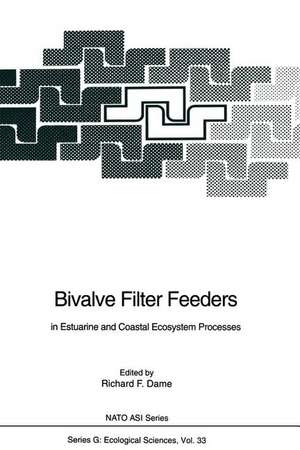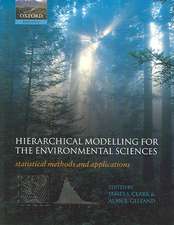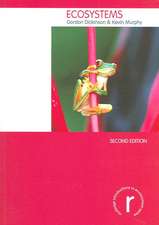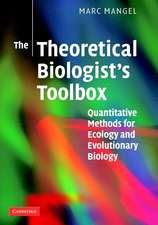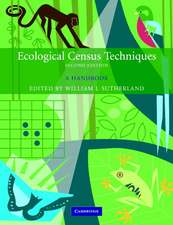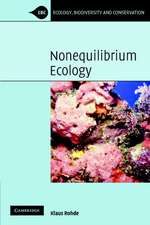Bivalve Filter Feeders: in Estuarine and Coastal Ecosystem Processes: Nato ASI Subseries G:, cartea 33
Editat de Richard F. Dameen Limba Engleză Paperback – 4 ian 2012
Din seria Nato ASI Subseries G:
- 15%
 Preț: 662.62 lei
Preț: 662.62 lei - 18%
 Preț: 979.22 lei
Preț: 979.22 lei - 18%
 Preț: 956.50 lei
Preț: 956.50 lei - 15%
 Preț: 657.08 lei
Preț: 657.08 lei - 18%
 Preț: 949.10 lei
Preț: 949.10 lei - 18%
 Preț: 1235.25 lei
Preț: 1235.25 lei - 18%
 Preț: 967.40 lei
Preț: 967.40 lei - 15%
 Preț: 663.93 lei
Preț: 663.93 lei - 18%
 Preț: 957.44 lei
Preț: 957.44 lei - 15%
 Preț: 642.51 lei
Preț: 642.51 lei - 18%
 Preț: 950.96 lei
Preț: 950.96 lei - 5%
 Preț: 710.60 lei
Preț: 710.60 lei - 18%
 Preț: 979.08 lei
Preț: 979.08 lei - 5%
 Preț: 1107.06 lei
Preț: 1107.06 lei - 15%
 Preț: 650.69 lei
Preț: 650.69 lei - 18%
 Preț: 966.27 lei
Preț: 966.27 lei - 18%
 Preț: 958.56 lei
Preț: 958.56 lei - 18%
 Preț: 958.56 lei
Preț: 958.56 lei - 18%
 Preț: 962.49 lei
Preț: 962.49 lei - 15%
 Preț: 650.19 lei
Preț: 650.19 lei - 15%
 Preț: 653.33 lei
Preț: 653.33 lei - 18%
 Preț: 960.78 lei
Preț: 960.78 lei - 15%
 Preț: 657.57 lei
Preț: 657.57 lei - 18%
 Preț: 959.50 lei
Preț: 959.50 lei - 15%
 Preț: 640.06 lei
Preț: 640.06 lei - 18%
 Preț: 959.19 lei
Preț: 959.19 lei - 15%
 Preț: 647.40 lei
Preț: 647.40 lei - 15%
 Preț: 649.71 lei
Preț: 649.71 lei - 18%
 Preț: 950.03 lei
Preț: 950.03 lei - 15%
 Preț: 655.13 lei
Preț: 655.13 lei - 18%
 Preț: 950.96 lei
Preț: 950.96 lei -
 Preț: 391.02 lei
Preț: 391.02 lei - 5%
 Preț: 1650.15 lei
Preț: 1650.15 lei - 15%
 Preț: 641.03 lei
Preț: 641.03 lei - 18%
 Preț: 1228.96 lei
Preț: 1228.96 lei - 15%
 Preț: 652.49 lei
Preț: 652.49 lei - 15%
 Preț: 670.17 lei
Preț: 670.17 lei - 18%
 Preț: 955.88 lei
Preț: 955.88 lei - 15%
 Preț: 647.59 lei
Preț: 647.59 lei - 18%
 Preț: 957.13 lei
Preț: 957.13 lei
Preț: 958.38 lei
Preț vechi: 1168.76 lei
-18% Nou
Puncte Express: 1438
Preț estimativ în valută:
183.41€ • 199.15$ • 154.06£
183.41€ • 199.15$ • 154.06£
Carte tipărită la comandă
Livrare economică 22 aprilie-06 mai
Preluare comenzi: 021 569.72.76
Specificații
ISBN-13: 9783642783555
ISBN-10: 3642783554
Pagini: 592
Ilustrații: VII, 579 p.
Dimensiuni: 155 x 235 x 31 mm
Greutate: 0.82 kg
Ediția:Softcover reprint of the original 1st ed. 1993
Editura: Springer Berlin, Heidelberg
Colecția Springer
Seria Nato ASI Subseries G:
Locul publicării:Berlin, Heidelberg, Germany
ISBN-10: 3642783554
Pagini: 592
Ilustrații: VII, 579 p.
Dimensiuni: 155 x 235 x 31 mm
Greutate: 0.82 kg
Ediția:Softcover reprint of the original 1st ed. 1993
Editura: Springer Berlin, Heidelberg
Colecția Springer
Seria Nato ASI Subseries G:
Locul publicării:Berlin, Heidelberg, Germany
Public țintă
ResearchCuprins
Feeding Physiology of Bivalves: Time Dependence and Compensation for Changes in Food Availability.- Infaunal Filter-Feeding Bivalves and the Physiological Response to Short-Term Fluctuations in Food Availability and Composition.- Phytoplankton-Mussel Bed Interactions in Intertidal Ecosystems.- Grazing of Natural Particulates by Bivalve Molluscs: A Spatial and Temporal Perspective.- Invertebrate Predators and their Role in Structuring Coastal and Estuarine Populations of Filter Feeding Bivalves.- The Impact of Bird Predation on Marine and Estuarine Bivalve Populations: A Selective Review of Patterns and Underlying Causes.- The Role of Bivalve Filter Feeder Material Fluxes in Estuarine Ecosystems.- The Uptake of Organic Matter and the Release of Inorganic Nutrients by Bivalve Suspension Feeder Beds.- Hydrodynamic Control of Bivalve Filter Feeders: A Conceptual View.- Bivalve Feeding and the Benthic Boundary Layer.- Perspectives on Field Studies and Related Biological Models of Bivalve Growth and Carrying Capacity.- A Set of Models to Investigate the Role of Benthic Suspension Feeders in Estuarine Ecosystems.- Why Carrying Capacity Models are Useful Tools for Management of Bivalve Molluscs Culture.- Integrated Estuarine Management — Obtaining a Sustainable Yield of Bivalve Resources While Maintaining Environmental Quality.- Poster Abstracts.- Working Group Reports: Physiology and Grazing.- Predation and Population Dynamics.- Material Processing.- Modelling.- Physical Factors.- The Role of Scientists in the Management of Coastal Ecosystems.- Bivalve Filter Feeders and Estuarine and Coastal Ecosystem Processes: Conclusions.
